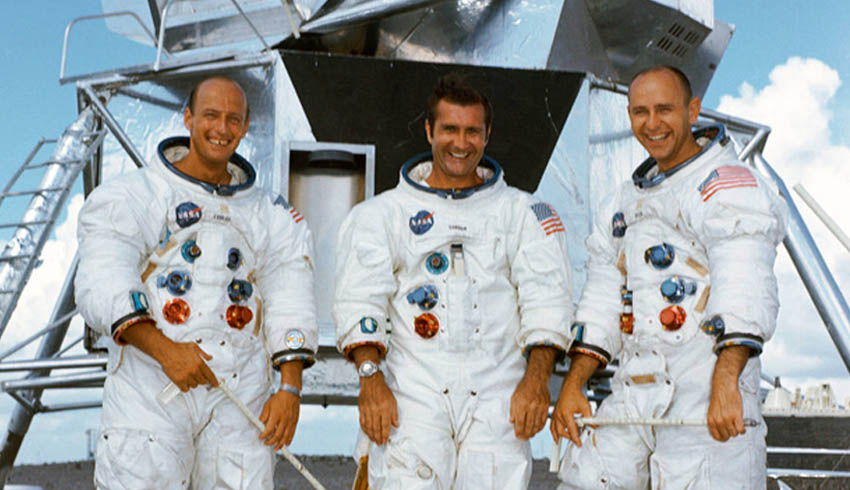Where Apollo 11 was super serious – how could it have been otherwise – Apollo 12 has since been branded the fun mission, with a knockabout all-US Navy team who did the job and had plenty of laughs along the way.
The Apollo 12 team comprised Commander Pete Conrad, lunar module pilot Al Bean and command module pilot Dick Gordon.
Among their (non-NASA approved) achievements was taking porn to the moon, a prank courtesy of the USAF back-up crew who inserted reduced size nude pin-ups into crew checklists, the multi-page memory aids worn by Bean and Conrad on their spacesuit wrists.
These featured Playboy playmates, which were accompanied by captions such as: Seen Any Interesting Hills and Valleys, and Don't Forget to Describe the Protuberances.
By 2019 standards, this material is pretty tame but one of the playmates was aged 17 when photographed, so some of what went to the moon was, in fact, illegal.
Gordon, orbiting the moon, wasn’t left out. He discovered a calendar in the command module featuring another Playboy playmate.
Apollo 12 blasted off on 14 November 1969, returning to Earth on 24 November. The lander touched down early on 19 November and departed late the next day.
Conrad and Bean conducted two moon walks, lasting almost eight hours.
The mission could have been a disaster from the outset. Blasting off in cloudy stormy skies and high winds, lightning twice struck the Saturn V rocket shortly after launch, knocking various systems including main power supplies and some telemetry offline.
At mission control, engineer John Aaron remembered an obscure fix from earlier trials, which Bean, flying as system engineer, was able to implement.
On the ground, it was feared the lightning might have fired explosive bolts for the command module parachute comportment, making a safe return impossible. It was decided not to advise the crew as there was nothing they could have done to fix the problem.
Once in orbit, a check over all systems revealed no damage and the parachutes worked properly on re-entry.
For the moon landing, Conrad precisely piloted the lander to touch down in the Ocean of Storms, 177 metres away from the designated spot called Pete’s Parking Lot, which he saw was rougher than anticipated.
The Ocean of Storms was the location of three earlier probes and Apollo 12 landed within easy walking distance of Surveyor 3, which touched down in April 1967. That’s the only time humans have visited a probe sent to another world.
When Neil Armstrong set foot on the moon, he spoke those famous words: That’s one small step for man … etc.”
Conrad had his own version.
“Whoopie! Man, that may have been a small one for Neil, but that's a long one for me,” he said.
That wasn’t spontaneous. Conrad made a US$500 bet with Italian reporter Oriana Fallaci that he would say these words as he stepped onto the moon surface.
She had insisted NASA had instructed Armstrong what to say. Conrad never collected.
Plans to broadcast colour TV from the moon ended abruptly after less than an hour when Bean inadvertently pointed the camera directly at the sun, destroying its sensor
Unlike Apollo 11, this wasn’t such a big deal. Most conveniently for US TV viewers, Apollo 11 occurred on a Sunday night, whereas Apollo 12 occurred early on a Tuesday morning when few were watching.
With only audio coming from the moon, US TV network CBS cut to a studio were a pair of actors in space suits pantomimed what was happening. NBC went one better, using astronaut marionettes.
The next morning, US newspaper The Plain Dealer printed the first images of the My Lai Massacre in Vietnam where US troops murdered as many as 500 Vietnamese villagers. This was electrifying news and Apollo 12 couldn’t compete.
Apollo 12 did involve plenty of useful science, bringing back rock samples and also some bits of Surveyor 3 to assess the effect of two years of exposure to the moon environment.
All three Apollo 12 astronauts remained close throughout their lives.
Conrad died of injuries from a motorcycle accident in 1999 and in commemoration, NASA planted a tree in his honour at the memorial grove for fallen astronauts at the Johnson Space Center in Houston.
Bean lightened the sombre ceremony by pretending to channel Conrad from the hereafter, declaring he wanted his tree lit with red lights every Christmas, in line with his personal motto “when you can’t be good be colourful”.
NASA has obliged. Every Christmas since, Conrad’s tree is adorned with red lights, while every other astronaut’s tree gets white lights.
Dick Gordon died in 2017 aged 88 while Alan Bean died last year, aged 86.
Like Apollo 11, Apollo 12 was tracked through stations in Australia, including Honeysuckle Creek outside Canberra, which relayed the television imagery of Armstrong’s first step.
Those at Honeysuckle Creek watched in horror as Bean pointed the TV camera at the sun and the image disappeared.
“The rest of the lunar activities were followed from the Earth only with sound,” wrote former Honeysuckle technician Hamish Lindsay in an essay on the Apollo 12 mission.
“To us at the tracking station it was quite strange to only have black screens around, and the normally busy video section helping the telemetry technicians.
“Luckily the personalities of Conrad, with his infectious chuckles, dum-de-dum dums, and Bean with his enthusiastic descriptions, entertained us as they whooped, hummed, joked, and rollicked around, already quite at home in this alien new environment.”

